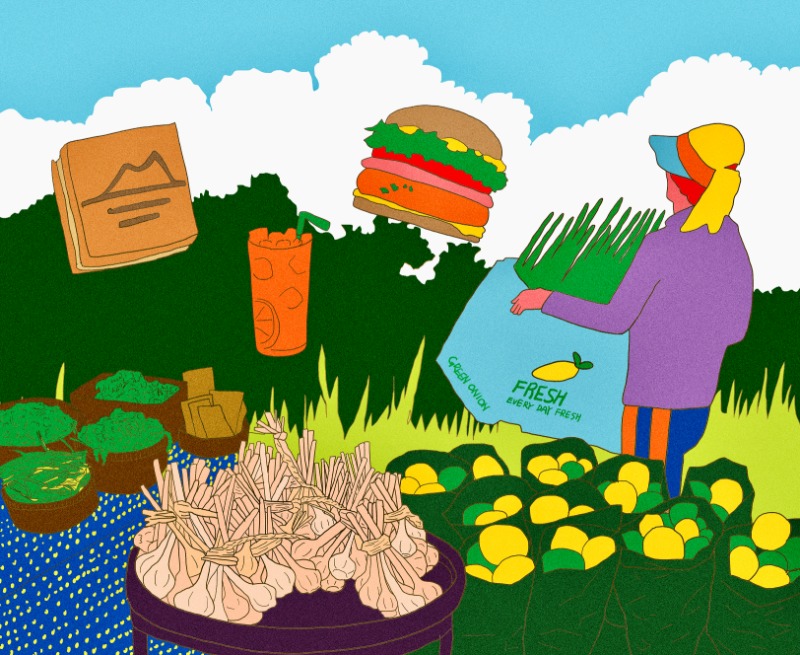‘Loconomy’ Offers Unique Experience
 Recently, “loconomy” has become a hot social and cultural trend in Korea. The term is a portmanteau that combines the words “local” and “economy.” As such, it refers to a way of supporting and boosting regional commerce.Loconomy begins by identifying the distinct and attractive characteristics of a city, county, or region. These characteristics are then used to promote the sale and consumption of goods.To do this, local producers collaborate with food companies to develop products that showcase the uniqueness of their regions. The authentic quality of the products, in turn, draws the interest of consumers.For example, the fast-food franchise, McDonald’s, recently introduced a new burger containing green onions from Jindo. The island in South Jeolla Province is famous for harvesting green onions with a strong aroma and flavor. The “Jindo Green Onion” burger sold out when it was offered for a limited time.Another example is the Gapyeong Matnam Sand, which is exclusively offered at a Paris Baguette bakery in the Gapyeong Service Area, a famous rest-stop on the Seoul-Yangyang Expressway. It is a sweet pastry made with pine nuts that are harvested in Gapyeong, Gyeonggi Province. The delicious dessert promotes the region while simultaneously supporting local farmers.Such loconomy products have helped to raise awareness of the unique qualities found in different regions around the nation. They have especially been popular with consumers in their 20s and 30s, who often look to find meaning in their purchases.In essence, these individuals are spending money not only to receive a product, but also to have a memorable cultural experience. In turn, their purchases are greatly contributing to regional development.
Recently, “loconomy” has become a hot social and cultural trend in Korea. The term is a portmanteau that combines the words “local” and “economy.” As such, it refers to a way of supporting and boosting regional commerce.Loconomy begins by identifying the distinct and attractive characteristics of a city, county, or region. These characteristics are then used to promote the sale and consumption of goods.To do this, local producers collaborate with food companies to develop products that showcase the uniqueness of their regions. The authentic quality of the products, in turn, draws the interest of consumers.For example, the fast-food franchise, McDonald’s, recently introduced a new burger containing green onions from Jindo. The island in South Jeolla Province is famous for harvesting green onions with a strong aroma and flavor. The “Jindo Green Onion” burger sold out when it was offered for a limited time.Another example is the Gapyeong Matnam Sand, which is exclusively offered at a Paris Baguette bakery in the Gapyeong Service Area, a famous rest-stop on the Seoul-Yangyang Expressway. It is a sweet pastry made with pine nuts that are harvested in Gapyeong, Gyeonggi Province. The delicious dessert promotes the region while simultaneously supporting local farmers.Such loconomy products have helped to raise awareness of the unique qualities found in different regions around the nation. They have especially been popular with consumers in their 20s and 30s, who often look to find meaning in their purchases.In essence, these individuals are spending money not only to receive a product, but also to have a memorable cultural experience. In turn, their purchases are greatly contributing to regional development. Questions:1. What is "loconomy," and how does it support regional commerce?2. How do local producers collaborate with food companies to promote their regions' uniqueness?3. Can you provide an example of a "loconomy" product mentioned in the article and describe its uniqueness?4. Who is the primary target demographic for these "loconomy" products, and why are they popular with this group?
Questions:1. What is "loconomy," and how does it support regional commerce?2. How do local producers collaborate with food companies to promote their regions' uniqueness?3. Can you provide an example of a "loconomy" product mentioned in the article and describe its uniqueness?4. Who is the primary target demographic for these "loconomy" products, and why are they popular with this group?5. Do you think the "loconomy" concept would work in other countries? Why or why not? What role do you think consumer preferences and values play in the success of the "loconomy" trend?
